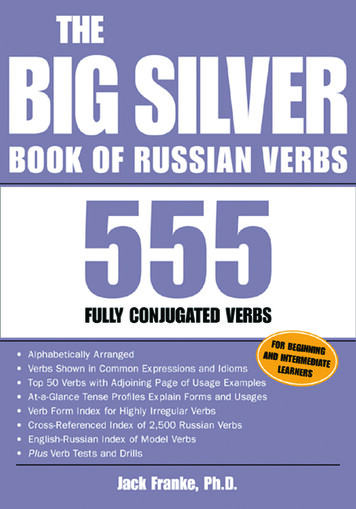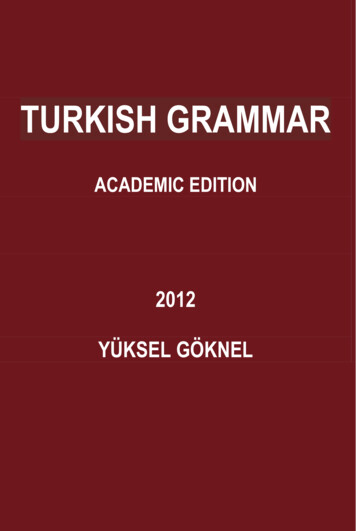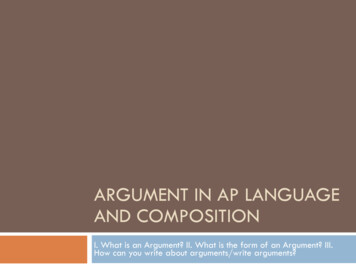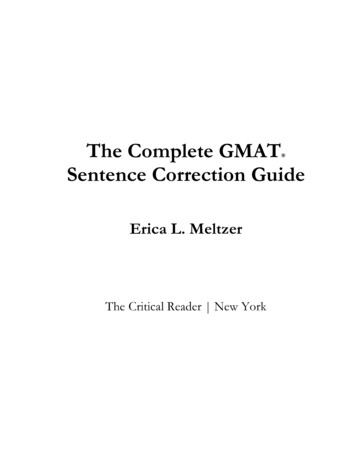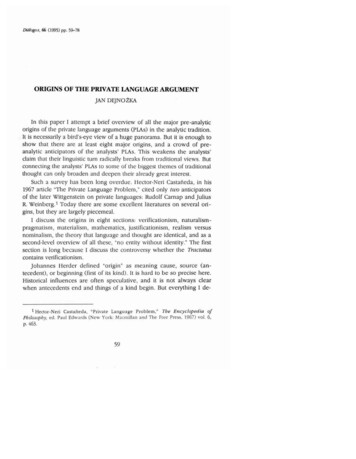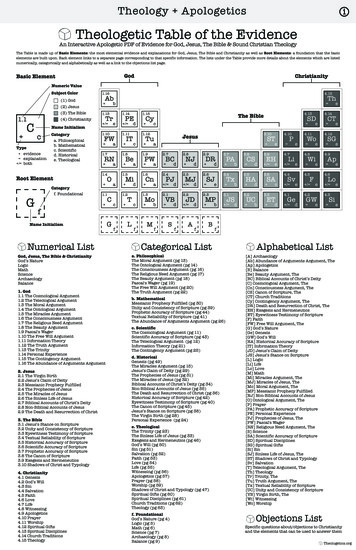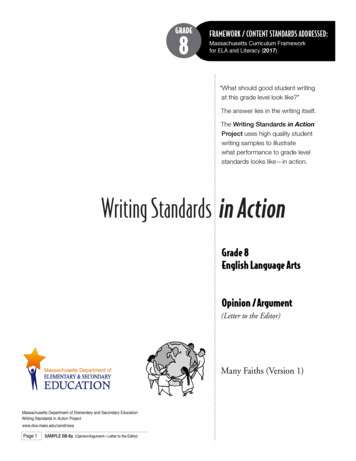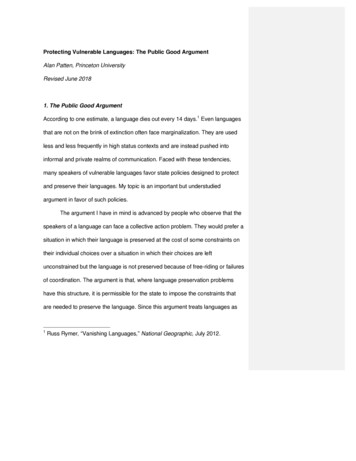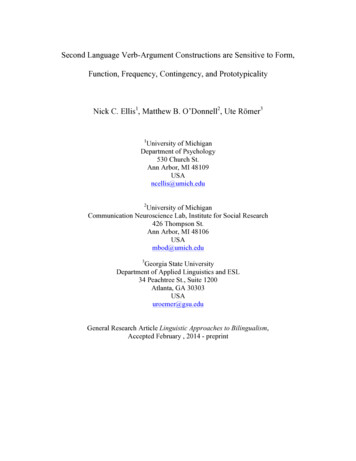
Transcription
Second Language Verb-Argument Constructions are Sensitive to Form,Function, Frequency, Contingency, and PrototypicalityNick C. Ellis1, Matthew B. O’Donnell2, Ute Römer31University of MichiganDepartment of Psychology530 Church St.Ann Arbor, MI 48109USAncellis@umich.edu2University of MichiganCommunication Neuroscience Lab, Institute for Social Research426 Thompson St.Ann Arbor, MI 48106USAmbod@umich.edu3Georgia State UniversityDepartment of Applied Linguistics and ESL34 Peachtree St., Suite 1200Atlanta, GA 30303USAuroemer@gsu.eduGeneral Research Article Linguistic Approaches to Bilingualism,Accepted February , 2014 - preprint
L2 Verb-Argument Constructions p. 1AbstractWe used free association tasks to investigate second language (L2) verb-argumentconstructions (VACs) and the ways in which their access is sensitive to statistical patternsof usage (verb type-token frequency distribution, VAC-verb contingency, verb-VACsemantic prototypicality). 131 German, 131 Spanish, and 131 Czech advanced L2learners of English generated the first word that came to mind to fill the V slot in 40sparse VAC frames such as ‘he across the.’, ‘it of the.’, etc. For each VAC, wecompared these results with corpus analyses of verb selection preferences in 100 millionwords of usage and with the semantic network structure of the verbs in these VACs. Forall language groups, multiple regression analyses predicting the frequencies of verb typesgenerated for each VAC show independent contributions of (i) verb frequency in theVAC, (ii) VAC-verb contingency, and (iii) verb prototypicality in terms of centralitywithin the VAC semantic network. L2 VAC processing involves rich associations, tunedby verb type and token frequencies and their contingencies of usage, which interfacesyntax, lexis, and semantics.KeywordsConstruction Grammar, Usage-based acquisition and processing, Free Association task,Semantic Networks, Contingency, Processing, Transfer
L2 Verb-Argument Constructions p. 21Constructing a second languageCognitive linguistic theories of construction grammar posit that languagecomprises many thousands of constructions -- form-meaning mappings, conventionalizedin the speech community, and entrenched as language knowledge in the learner’s mind(Goldberg, 1995; Robinson & Ellis, 2008b; Trousdale & Hoffmann, 2013). Usage-basedapproaches to language acquisition hold that schematic constructions emerge asprototypes from the conspiracy of memories of particular exemplars that language usershave experienced. There are many commonalities between first language (L1) and secondlanguage acquisition (L2A) that can thus be informed by corpus analyses of input andfrom cognitive- and psycho-linguistic investigation of construction acquisition followingassociative and cognitive principles of learning and categorization, hence increasedattention to usage-based approaches within L2A research (Collins & Ellis, 2009; Ellis,1998, 2003; Ellis & Cadierno, 2009; Robinson & Ellis, 2008b). This paper investigatesL2 processing of abstract Verb-Argument Constructions (VACs) and its sensitivity to thestatistics of usage in terms of verb exemplar type-token frequency distribution, VAC-verbcontingency, and VAC-verb semantic prototypicality.Our experience of language allows us to converge upon similar interpretations ofnovel utterances like “it mandooled across the floor” and “she spugged him the borg.”You know that mandool is a verb of motion and have some idea of how mandoolingworks – its action semantics. You know that spugging involves some sort of gifting, thatshe is the donor, he the recipient, and that the borg, whatever that is, is the transferredobject. How is this possible, given that you have never heard these verbs before? Onepossibility is that there is a close relationship between the types of verb that typically
L2 Verb-Argument Constructions p. 3appear within constructions, hence their meaning as a whole is inducible from the lexicalitems experienced within them. So your reading of “it mandools across the ” is drivenby an abstract ‘V across noun’ VAC which has inherited its schematic meaning from allof the relevant examples you have heard and your interpretation of mandool emergesfrom the echoes of the verbs that occupy this VAC – the 'exemplar cloud' of tokensincluding come, walk, move,., scud, skitter and flit.The specific claim under test in this paper is that L2 speakers, like L1 speakers,have schematic VAC meanings that are inherited from the constituency of all of the verbexemplars experienced within them, weighted according to the frequency of theirexperience and the reliability of their association to that construction (their contingency),and their degree of prototypicality in the semantics of the VAC.Previous research which addressed this claim for L1 speakers involved two steps,first an analysis of VACs in a large corpus of representative usage, and second ananalysis of the processing of these VACs by fluent native speakers.In step one, Ellis and O’Donnell (2011, 2012) investigated the type-tokendistributions of 20 Verb-Locative (VL) VACs such as ‘V(erb) across n(oun phrase)’ in a100-million-word corpus of English usage. The other locatives sampled were about,after, against, among, around, as, at, between, for, in, into, like, of, off, over, through,towards, under, and with. They searched a dependency-parsed version of the BritishNational Corpus (BNC, 2007) for specific VACs previously identified in the GrammarPatterns volume resulting from the COBUILD corpus-based dictionary project (Francis,Hunston, & Manning, 1996). The details of the linguistic analyses, as well assubsequently modified search specifications in order to improve precision and recall, are
L2 Verb-Argument Constructions p. 4described in Römer, O’Donnell, and Ellis (in press, 2013). This corpus linguistic researchdemonstrated:(1) The frequency profile of the verbs in each VAC follows a Zipfian profile(Zipf, 1935) whereby the highest frequency types account for the most linguistic tokens.Zipf’s law states that in human language, the frequency of words decreases as a powerfunction of their rank.(2) The most frequent verb in each VAC is prototypical of that construction’sfunctional interpretation, albeit generic in its action semantics.(3) VACs are selective in their verb form family occupancy: individual verbsselect particular constructions; particular constructions select particular verbs; there ishigh contingency between verb types and constructions. This means that the Zipfianprofiles seen in (1) are not those of the verbs in English as a whole – instead theirconstituency and rank ordering are special to each VAC.(4) VACs are coherent in their semantics. This was assessed using WordNet(Miller, 2009), a distribution-free semantic database based upon psycholinguistic theory,as an initial resource to investigate the similarity/distance between verbs. Then networksscience, graph-based algorithms (de Nooy, Mrvar, & Batagelj, 2010) were used to buildsemantic networks in which the nodes represent verb types and the edges strong semanticsimilarity for each VAC. Standard measures of network density, average clustering,degree centrality, transitivity, etc. were then used to assess the cohesion of these semanticnetworks and verb type connectivity within the network. Betweenness centrality was usedas a measure of a verb node's centrality in the VAC network (McDonough & De
L2 Verb-Argument Constructions p. 5Vleeschauwer, 2012). In semantic networks, central nodes are those which areprototypical of the network as a whole.In step 2, Ellis, O'Donnell, and Römer (in press) used free association and verbalfluency tasks to investigate verb-argument constructions (VACs) and the ways in whichtheir processing is sensitive to these statistical patterns of usage (verb type-tokenfrequency distribution, VAC-verb contingency, verb-VAC semantic prototypicality). Inexperiment 1, 285 native speakers of English generated the first word that came to mindto fill the V slot in 40 sparse VAC frames such as ‘he across the.’, ‘it of the.’,etc. In experiment 2, 40 English speakers generated as many verbs that fit each frame asthey could think of in a minute. For each VAC, they compared the results from theexperiments with the corpus analyses of usage described above for step 1. For bothexperiments, multiple regression analyses predicting the frequencies of verb typesgenerated for each VAC showed independent contributions of (i) verb frequency in theVAC, (ii) VAC-verb contingency, and (iii) verb prototypicality in terms of centralitywithin the VAC semantic network. Ellis et al. (in press) contend that the fact that nativespeaker VACs implicitly represent the statistics of language usage implies that they arelearned from usage. Further, usage-based linguists (e.g., Boyd & Goldberg, 2009; Bybee,2008, 2010; Ellis, 2008a; Goldberg, 2006; Goldberg, Casenhiser, & Sethuraman, 2004;Lieven & Tomasello, 2008; Ninio, 1999), influenced by psychological theory relating tothe statistical learning of categories, have proposed that these three factors make conceptsrobustly learnable -- that it is the Zipfian coming together of linguistic form and functionthat makes language learnable despite learners’ idiosyncratic experience.To test the generalizability of these phenomena to L2A, this paper extends the
L2 Verb-Argument Constructions p. 6methods of step 2 to test German, Spanish, and Czech advanced learners forcomparability with the native English speakers from Ellis et al. (in press).2Experiments: L2 sensitivity to VAC usageIn order to determine whether these factors affect L2 VAC processing, we usedthe same free-association tasks asking respondents to generate the verbs that come tomind when they see schematic VAC frames such as ‘he across the.’, ‘it of the.,’etc. Free-association tasks like this are standard in psychology for determining categoryrepresentation (Battig & Montague, 1969; Rosch & Mervis, 1975; Rosch, Mervis, Gray,Johnson, & Boyes-Braem, 1976). Similar methods have also been used in cognitivelinguistic investigations of construction grammar (Dąbrowska, 2009).2.1ParticipantsThe participants were predominantly university students recruited through emailssent by members or associates of the research team, either to the students directly or toone of their instructors. The L1 German, L1 Czech, and L1 Spanish learners werestudents enrolled at research universities in Germany, the Czech Republic, and Spaini.The mean number of years of English instruction was 10.04 years for German, 11.37 forCzech, and 12.68 for Spanish learners. L1 English speakers were mostly studentsenrolled at a large mid-western research university. The following numbers ofparticipants volunteered to complete the VAC survey: 285 native English speakers, 276L1 German learners of English, 185 L1 Czech learners of English, and 131 L1 Spanishlearners of English. To ensure comparability across datasets, we based our analyses ononly 131 responses from each of the four participant groups, including all of the L1
L2 Verb-Argument Constructions p. 7Spanish responses and 131 randomly selected responses each from the native speaker, L1German, and L1 Czech groups.2.2MethodA survey was designed and delivered over the web using Qualtrics(http://www.qualtrics.com/). Participants were instructed: “We are going to show you aphrase with a verb missing, and ask you to fill in the gap with the first word that comes toyour mind. For example, for the phrase: he her the you might respond he gave herthe or he sent her the And for the phrase: it down the You might respond itrolls down the Or it fell down the On each page you will be presented with a phraselike one of these with a line indicating a missing word. In the text box type the first wordyou think of and press the [ENTER] key.” They then saw the 20 sentence frames shownin Table 1 shown once with the subject he/she and once with it. These 40 trials werepresented in a random order. We recorded their responses and the time they took on eachsentence. The survey as a whole took between 5 and 15 minutes. Responses werelemmatized using the Natural Language Toolkit (Bird, Loper, & Klein, 2009).Table 1 about here2.3Analyzing effects of FrequencyLearning, memory and perception are all affected by frequency of usage: The moretimes we experience something, the stronger our memory for it, and the more fluently itis accessed, the relation between frequency of experience and entrenchment following apower law (e.g., Anderson, 2000; Ellis, 2002; Ellis & Schmidt, 1998; Newell, 1990). Themore times we experience conjunctions of features or of cues and outcomes, the morethey become associated in our minds and the more these subsequently affect perception
L2 Verb-Argument Constructions p. 8and categorization (Harnad, 1987; Lakoff, 1987; Taylor, 1998). If constructions areacquired by general learning mechanisms, these general principles of cognition shouldapply to VACs too.This leads to Analysis 1: The accessibility of verb types as VAC exemplars in thegenerative tasks should be a function of their token frequencies in those VACs in usageexperience.2.4Analyzing effects of ContingencyContingency/reliability of form-function mapping and associated aspects ofpredictive value, information gain, and statistical association, are driving forces oflearning. They are central in psycholinguistic theories of language acquisition (Ellis,2006a, 2006b, 2008b; MacWhinney, 1987) and in cognitive/corpus linguistic analysestoo (Ellis & Cadierno, 2009; Ellis & Ferreira-Junior, 2009b; Evert, 2005; Gries, 2007,2012; Gries & Stefanowitsch, 2004; Stefanowitsch & Gries, 2003).This leads to Analysis 2: verbs which are faithful to particular VACs in usageshould be those which are more readily accessed by those VAC frames than verbs whichare more promiscuous. To measure this, we use the one-way dependency statisticP(Allan, 1980) shown to predict cue-outcome learning in the associative learning literature(Shanks, 1995) as well as in psycholinguistic studies of form-function contingency inconstruction usage, knowledge, and processing (Ellis, 2006a; Ellis & Ferreira-Junior,2009b; Gries, 2013).Table 2 about hereConsider the contingency table shown in Table 2. ΔP is the probability of theoutcome given the cue minus the probability of the outcome in the absence of the cue.
L2 Verb-Argument Constructions p. 9When these are the same, when the outcome is just as likely when the cue is present aswhen it is not, there is no covariation between the two events and ΔP 0. ΔP approaches1.0 as the presence of the cue increases the likelihood of the outcome and approaches –1.0 as the cue decreases the chance of the outcome – a negative association.ΔP P(O C) – P(O -C) (a/(a b)) - (c/(c d))ΔP is affected by the conjoint frequency of construction and verb in the corpus(a), but also by the frequency of the verb in the corpus, the frequency of the VAC in thecorpus, and the number of verbs in the corpus. For illustration, the lower part of Table 2considers three exemplars, lie across, stride across, and crowd into, which all have thesame conjoint frequency of 44 in a corpus of 17,408,901 VAC instances. This is the valuethat Analysis 1 would consider. However, while!ΔP Construction Word (ΔPcw) for lieacross and stride across are approximately the same, that for crowd into is an order ofmagnitude less.!ΔPwc shows a different pattern - the values for stride across and crowdinto are over ten times greater than for lie across. In this experiment, we are givingpeople the construction and asking them to generate the word, and ΔPcw is the relevantmetric.2.5Assessing the effects of Semantic PrototypicalityIn our analyses of VAC semantics in usage, we determined prototypicality interms of the centrality of the verb in the semantic network connecting the verb types thatfeature in that VAC (Ellis & O'Donnell, 2011, 2012). We used the measure ‘betweennesscentrality’ which was developed to quantify the control of a human on thecommunication between other humans in a social network (McDonough & DeVleeschauwer, 2012).
L2 Verb-Argument Constructions p. 10This leads to Analysis 3: The verb types that are produced more frequently in thegenerative tasks should be more prototypical of the VAC semantics as indexed by theirdegree in the semantic network of the VAC in our usage analyses.2.6ResultsThe verb types generated for each VAC were aggregated across participants andthe s/he or it prompt variants. Scrutiny of our corpus analyses demonstrated that we wereunable to achieve sufficient precision in our searching for the after, at, and in VACsbecause these occur in a wide variety of temporal references as well as locatives. Theywere therefore removed from subsequent analyses, leaving 17 VACs for the correlationsand regressions.We restrict analysis to the verb types that cover the top 95% of verb tokens inEnglish usage. In the BNC, the most frequent 961 verbs in English cover this range. Thisthreshold is necessary to avoid the long tail of the BNC frequency distribution (very lowfrequency types and hapax legomena) dominating the analyses. Without this step, resultsof such research are over-influenced simply by the size of the reference corpus - thelarger the corpus, the longer the tail (Malvern, Richards, Chipere, & Duran, 2004;Tweedie & Baayen, 1998).Statistical analyses were performed using R (R Development Core Team, 2012).All subsequent analyses involve the log10 transforms of the variables: (a) tokengeneration frequency in the VAC, (b) token frequency in that VAC in the BNC, (c) ΔPcwverb-VAC in the BNC, (d) verb centrality in the semantic network of that VAC, (e) verbfrequency in the whole BNC. To avoid missing responses as a result of logging zero, allvalues were incremented by 0.01.
L2 Verb-Argument Constructions p. 11Table 3 about here2.6.1Analysis 1We plot the lemmatized verb types for each VAC in the space defined by logtoken generation frequency against log token frequency in that VAC in the BNC. Theplot for ‘V of n’ is shown in Figure 1 for each of the language groups. Items appear onthe graph if the lemma both appears as a response in the generation task for that VAC andit also appears in the BNC. The font size for each verb plotted is proportional to thefrequency of that verb in the BNC as a whole. It can be seen that for the L1 Englishgroup, generation frequency follows verb frequency in that VAC in the BNC with acorrelation of r 0.77. After the copula be, cognition verbs (think and know) are the mostfrequent types, followed by communication verbs (speak, say, talk, ask), and alsoperception verbs (smell, hear). Thus the semantic sets of the VAC frame in usage are allsampled in the free association task, and the sampling follows the frequencies of usage.The responses for the three ESL groups pattern in a similar fashion: generation frequencyfollows verb frequency in that VAC in the BNC with a correlation of r 0.60 for the L1German group, r 0.68 for the L1 Spanish group, and r 0.58 for the L1 Czech group.Figure 1 about hereIllustrative plots of the responses for the VACs ‘V about n’, ‘V between n’, and‘V against n’ against frequencies of the verbs in that VAC in the BNC are shown inFigures 2, 3, and 4 where it can be seen that the advanced L2 English speakers generateda similar set of verb types for these VACs with similar token frequencies.Figures 2, 3 and 4 about here
L2 Verb-Argument Constructions p. 12For each VAC we correlate verb generation frequency against verb frequency inthe VAC in the BNC. These correlations are shown in the third column of Table 3, theirsignificance levels in column 4 of Table 3 for the native English respondents. These arenon-trivial correlations. Their mean is 0.55. The same data are shown for the Germanrespondents in Table 4 where the mean correlation is 0.59, for the Spanish respondents inTable 5 where the mean correlation is 0.65, and for the Czech respondents in Table 6where the mean correlation is 0.59. The responses of all language groups, L1 and L2alike, are sensitive to verb usage frequency in the VAC across the 17 constructionssampled.2.6.2Analysis 2To assess whether frequency of verb generation is associated with VAC-verbcontingency, we correlate this withPcw in the BNC. These correlations and theirsignificance levels are shown in columns 5 and 6 of Tables 3-6. Again they are nontrivial. Their mean is 0.48 for English L1, 0.53 for German, 0.63 for Spanish, and 0.56for Czech. Across the 17 constructions, the responses of all language groups, L1 and L2alike, are sensitive to VAC-verb contingency.2.6.3Analysis 3To determine whether frequency of verb generation is associated with semanticprototypicality of the VAC verb usage in the BNC, we correlate frequency of verbgeneration with the betweenness centrality of that verb in the semantic network of theverb types occupying that VAC in the BNC. These correlations and their significancelevels are shown in columns 7 and 8 of Tables 3-6. Their mean is 0.46 for English L1,
L2 Verb-Argument Constructions p. 130.44 for German, 0.43 for Spanish, and 0.35 for Czech. These associations are moremodest: 12/17 are significant in the L1 group and 27/51 in the L2 samples.2.6.4Combined analysesThese analyses VAC by VAC and variable by variable have shown that each ofour potential causal variables is associated with verb generation frequency. Nevertheless,within each analysis the sample sizes are rather low. Sampling 131 tokens from a Zipfiandistribution, where the lead item gets the lion’s share, results in variability in the lowerfrequency items which a respondent might, or might not, generate. Ideally such researchwould involve larger samples of respondents, or, as in Ellis, O’Donnell & Römer (inpress) Experiment 2, more responses per participant.However, we can obtain more power of analysis, as well as assess generalization,by looking across the constructions to assess the degree to which these patterns holdacross the VACs analyzed here, and the degree to which each causal variable makes anindependent contribution. Therefore we stacked the generation data for the differentVACs into a combined data set. We included cases where the verb appeared in thelanguage group generations for that VAC and in the BNC in that VAC. If we look withina construction, since the construction frequency remains constant, words with similarconjoint frequencies have similar ΔPcw, hence the similar sizes of correlation forfrequency and ΔPcw in Tables 3-6. However when, as here, we compare across VACs ofvery different frequencies in the corpus (from lows of 1459 for off, 2551 among, up to84,648 for and 89,745 with), verbs with the same conjoint frequency will have markedlydifferent ΔPcw (as in the cases of stride across and crowd into in Table 2).
L2 Verb-Argument Constructions p. 14The next step is to use these data sets to perform, for each language group, amultiple regression of log generation frequency against log BNC verb frequency in thatVAC, log ΔPcw, and log verb betweenness centrality in that VAC usage in the BNC,entering all three independent variables into the regression using glm in R. We also usedthe R package relaimpo (Grömping, 2006) to calculate the relative importance of theircontributions. The resultant coefficients are shown in Table 7.Consider first the English L1 group. Each of the three predictors makes a highlysignificant independent contribution in explaining the generation data at p .01. Themajor predictor is ΔPcw (Relative Importance 0.40), followed by verb betweennesscentrality in the semantic network for VAC usage in the BNC (lmg 0.31 and BNC verbfrequency in that VAC (lmg 0.29.) Tests for collinearity of the independent variablesproduce low variance inflation factors well within acceptable limits. All three predictorsalso make significant independent contributions using rlm robust regression in R (Fox,2002). The R effects library (Fox, 2003) was used to graph the effects of each of thepredictors. The top row of Figure 5 shows these with confidence intervals for English logL1 frequencies of verb types generated for a VAC frame against (i) log frequencies ofthat verb type in that VAC frame in the BNC, (ii) log ΔPcw association strength of thatverb given that VAC in the BNC, and (iii) log betweenness centrality of that verb in thatVAC semantic network from the BNC data, pooled across the 17 VACs analyzed.Now consider the L2 learner groups. Each of the three predictors makes a highlysignificant independent contribution in explaining the generation data for each languagegroup, German, Spanish, and Czech, at p .01. The patterns of Relative Importance areof the same order: Contingency Frequency Prototypicality. The bottom row of Figure 5
L2 Verb-Argument Constructions p. 15shows the effects plots for L1 German. The effects plots for L1 Spanish and Czechgroups are shown in Figure 6. The influences of the three causal variables are allsignificant, and are of a similar magnitude, in each of the language groups.Table 7 about hereFigures 5 and 6 about here3DiscussionThese findings demonstrate that for L1 and advanced L2 speakers alike, particularverbs are associated with skeletal schematic syntactic VAC frames like s/he of, it on, etc. Which verbs come to mind when these fluent language users consider theseprompts are determined by three factors:1. Entrenchment - verb token frequencies in those VACs in usageexperience;2. Contingency - how faithful verbs are to particular VACs in usageexperience;3. Semantic prototypicality - the centrality of the verb meaning in thesemantic network of the VAC in usage experience.We take this as evidence for common processes of construction learning fromusage in both first and second language acquisition. Not only do these factors showstrong and significant zero-order correlations with productivity in the generative task, butmultiple regression analyses show that they make significant independent contributions.These factors have been implicated in usage-based approaches to SLA (e.g., Ellis, 2002,
L2 Verb-Argument Constructions p. 162008b), although they have not been properly addressed within the same empirical study:1. Effects of frequency of usage upon language learning, ENTRENCHMENT, andsubsequent fluency of linguistic processing are well documented and understood in termsof Hebbian learning (Bybee, 2010; Bybee & Hopper, 2001; Ellis, 2002; MacWhinney,2001).2. Effects of CONTINGENCY of association are also standard fare in the psychologyof learning (Rescorla & Wagner, 1972; Shanks, 1995), in the psychology of languagelearning (Ellis, 2006a, 2006b; MacWhinney, 1987; MacWhinney, Bates, & Kliegl, 1984),and in the particular cases of English VAC acquisition (Ellis & Ferreira-Junior, 2009a,2009b; Ellis & Larsen-Freeman, 2009) and German L2 English learners’ verb-specificknowledge of VACs as demonstrated in priming experiments (Gries & Wulff, 2005,2009).3. We interpret the effects of semantic PROTOTYPICALITY in terms of the spreadingactivation theory of semantic memory (Anderson, 1983). The prototype has twoadvantages: The first is a frequency factor: the greater the token frequency of anexemplar, the more it contributes to defining the category, and the greater the likelihoodit will be considered the prototype (Rosch & Mervis, 1975; Rosch et al., 1976). Thus it isthe response that is most associated with the VAC in its own right. But beyond that, itgets the network centrality advantage. When any response is made, it spreads activationand reminds other members in the set. The prototype is most connected at the center ofthe network and, like Rome, all roads lead to it. Thus it receives the most spreadingactivation. We discuss this further in Ellis et al. (in press).
L2 Verb-Argument Constructions p. 17In the present paper, we investigate L2 constructions in order to relate them toprior work with fluent L1 speakers (Ellis et al., in press). Like the L1 speakers, and to asimilar extent, German, Czech, and Spanish L1 advanced learners of English as an L2showed independent effects of frequency, contingency, and prototypicality. Thesefindings suggest that the learning of constructions as form-meaning pairs, like theassociative learning of cue-outcome contingencies, are affected by factors relating to theform such as type and token frequency; factors relating to the interpretation such asprototypicality and generality of meaning, and factors relating to the contingency of formand function. Language acquisition involves the distributional analysis of the languagestream and the parallel analysis of contingent perceptual activity, with abstractconstructions being learned from the conspiracy of concrete exemplars of usagefollowing statistical learning mechanisms (Christiansen & Chater, 2001; Rebuschat &Williams, 2012) relating input and learner cognition.However, despite these fundamental similarities with L1A, there are differencestoo. Languages lead their speakers to experience different ‘thinking for speaking’ andthus to construe experience in different ways (Slobin, 1996). Learning another languageinvolves learning how to construe the world like natives of the L2, i.e., learningalternative ways of thinking for speaking (Brown & Gullberg, 2008; Brown & Gullberg,2010; Cadierno, 2008) or learning to ‘rethink for speaking’ (Robinson & Ellis, 2008a).Transfer theories such as the Contrastive Analysis Hypothesis (Gass & Selinker, 1983;James, 1980; Lado, 1957, 1964) hold that L2 learning can be easier where languages usethese attention-directing devices in the same way, and more difficult when they use themdifferently. To the extent that the constructions in L2 are similar to those of L1, L1
L2 Verb-Argument Constructions p. 18constructions can serve as the basis for the L2
L2 Verb-Argument Constructions p. 2 1 Constructing a second language Cognitive linguistic theories of construction grammar posit that language comprises many thousands of constructions -- form-meaning mappings, conventionalized in the speech community, and entrenched as
